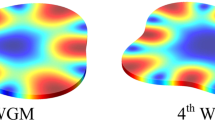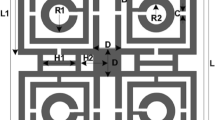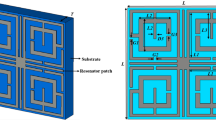Abstract
A new structure for RF MEMS resonators is demonstrated in UHF range. The presented resonator has the ability to work in multiple resonance modes by its specific anchor design. Also, its special electrodes are designed so that the desired mode at any time could be excited by embedding simple MOS switches. Since the resonance frequency of different modes could be adjusted by the inner radius of the resonator, the structure could be designed for wide range of arbitrary frequency differences between modes. Specific electrodes and anchors design guarantees low insertion loss and high quality factor in all modes. Modal and harmonic analysis verify our approach.










Similar content being viewed by others
References
Baghelani M, Badri Ghavifekr H (2010) Ring shape anchored RF MEMS contour mode disk resonators for UHF applications. Microsys Technol 16(12):2123–2130
Baghelani M, Badri Ghavifekr H, Ebrahimi A (2011) Analysis and suppression of spurious modes of the ring shape anchored RF MEMS contour mode disk resonator. Microsys Technol 17(11):1599–1609
Baghelani M, Badri Ghavifekr H, Ebrahimi A (2012) A new approach for the design of low velocity coupling for ring shape anchored contour mode disk resonators. Microsys Technol 18(12):2003–2016
Casset F, Durand C, Dedieu S, Carpentier JF, Gonchond JP, Ancey P, Robert P (2009) 3D Multi-frequency MEMS electromechanical resonator design. 10th international conference on thermal, mechanical and multi-physics simulation and experiments in microelectronics and microsystems, pp 1–5
Imadur Rahman M, Reynisson R, Figueiredo D, Prasad R (2009) Sub-carrier and band hopped orthogonal frequency division multiple access (OFDMA) system. Wireless Pers Commun 50(1):83–97
Nguyen CTC (2007) MEMS technology for timing and frequency control. IEEE T Ultrason Ferr 54(2):251–270
Nguyen CTC, Kitching J (2005) Towards chip-scale atomic clocks. IEEE International Solid-State Circuits Conference, pp 84–85
Pal J, Zhu Y, Lu J, Viet Dao D, Khan F (2015) RF MEMS switches for smart antennas. Microsys Technol 21(2):487–495
Piazza G, Stephanou PJ, Pisano AP (2007) Single-chip multiple-frequency ALN MEMS filters based on contour-mode piezoelectric resonators. J Microelectromech Syst 16(2):319–328
Rebeiz GM, Patel CD, Han SK, Chih-Hsiang K, Ho KMJ (2013) The search for a reliable MEMS switch. IEEE Microw Mag 14(1):57–67
Thirunarayanan R, Ruffieux D, Enz C (2015) Reducing energy dissipation in ULP systems: PLL-FreeFBAR-based fast startup transmitters. IEEE T Microw Theory 63(4):1110–1117
Wang J, Ren Z, Nguyen CTC (2004) 1.156-GHz self-aligned vibrating micromechanical disk resonator. IEEE T Ultrason Ferr 51(12):1607–1628
Author information
Authors and Affiliations
Corresponding author
Rights and permissions
About this article
Cite this article
Baghelani, M. Design of a multi-frequency resonator for UHF multiband communication applications. Microsyst Technol 22, 2543–2548 (2016). https://doi.org/10.1007/s00542-015-2639-8
Received:
Accepted:
Published:
Issue Date:
DOI: https://doi.org/10.1007/s00542-015-2639-8




